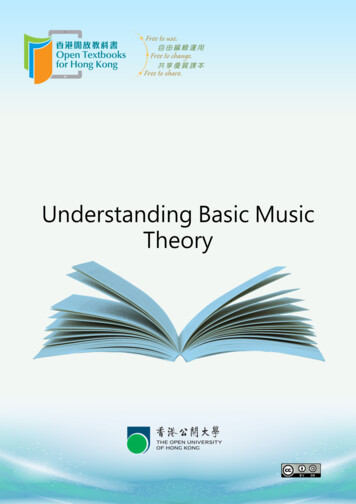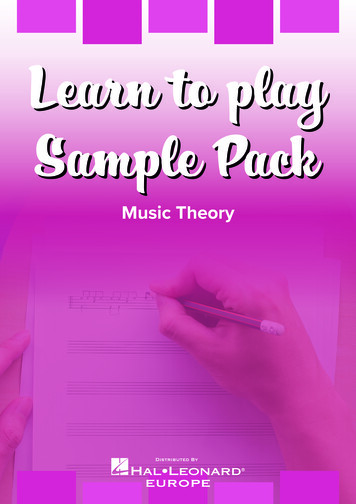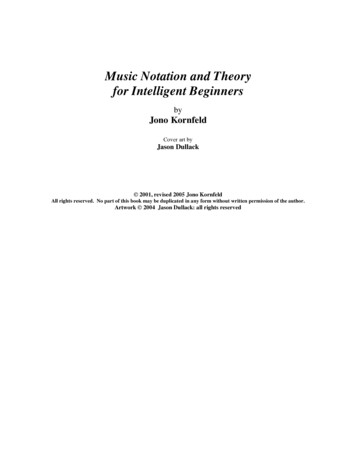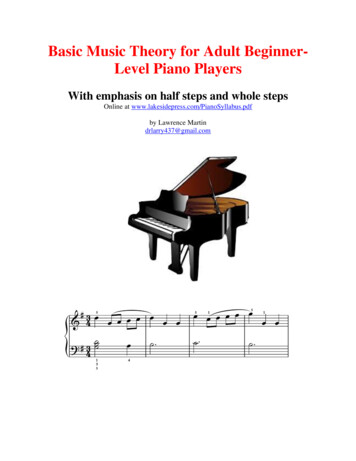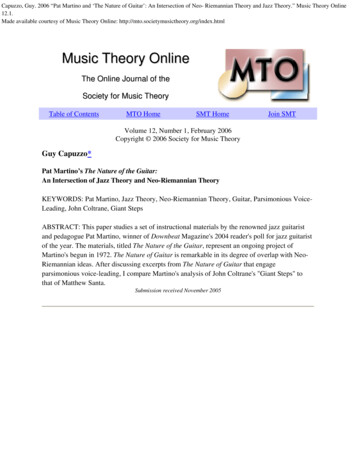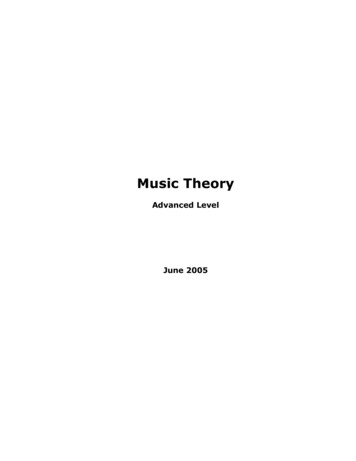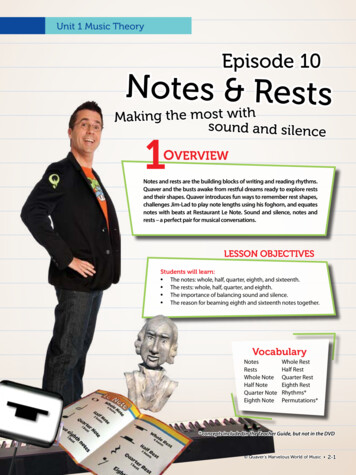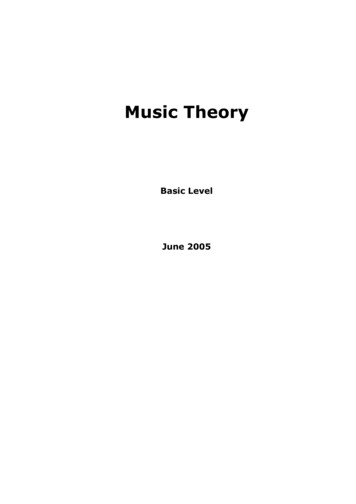
Transcription
Music TheoryBasic LevelJune 2005
Introduction . 3Intervals. 4Theory. 4Usage . 5Chords . 7Theory. 7Triads . 8Four-note chords . 8Usage . 8The Major Scale. 10Theory. 10Usage . 13The Minor Scales. 15Theory. 15The Natural Minor Scale. 15The Harmonic Minor Scale. 16The Melodic Minor Scale. 17Usage . 17References . 202
IntroductionThis document is part of a compilation of a series of threads that deal with music theory and thatwere originally published by Eowyn on www.mysongbook.com. The compilation has beenreorganized into three separate documents: Basic Music Theory – this document Intermediate Music Theory Advanced Music TheoryThis has been done for two reasons:1. The size of one single file was too large for download2. The material covered by the different topics is of varying levels of complexity andtargets different audiences.The text of the original threads has been modified and/or extended in several places where it wasdeemed appropriate for increased readability. The rather crude layout of the original text (due tothe limitation of the forum) has also been improved. Finally, the text has been proof-read byArnold and Blackiel.This is by no means an exhaustive treatise about music theory and harmony. Much moremodestly, the purpose of this series of topics is to give those willing to better understand what theyare doing with their guitar, the ability to get this knowledge into a quick and concise form. Theunderlying objective is lead work and improvisation in a rock music context (broadly speaking), butmost topics are of a more general nature and they can also easily be adapted to other musicalgenres.There are numerous books and web sites about general music theory and more specialised topics.Interested readers will find a short reference list at the end of the document.Copyright NoticeThe information contained in this document and this document itself can be freely downloaded,used and copied for private educational purposes only. Selling of this document is strictlyprohibited in all circumstances.3
IntervalsTheoryIntervals aren’t much fun to learn but they are essential and we'll need them: in the context of scales in order to define chords to help in analysing phrases and solosand most importantly, we absolutely need to know how to play them. So please, bear with me andread on.As you probably know, the whole western musical system is built on 12 notes:CDC#/DbD#/EbEFF#/GbGG#/AbAA#/BbBSome points worth noting: Some notes have two names (e.g. C# - "C sharp", or Db - "D flat"). This is requiredfor theoretical reasons that we will not go into but in practice they are one and thesame note. This ordered sequence of notes is called a scale; this particular one is the"chromatic scale". We'll get into scales in future topics. Between any pair of consecutive notes in the scale above, there is an equaldistance of a halftone (H); two halftones form a whole tone (W). Because of thatequal distance of a halftone, this scale is called equal-tempered. Why there areonly twelve notes and why there is that equal distance of a halftone between anypair of adjacent notes is a very complex subject that we won’t go into here.The "distance" between two arbitrary notes is called an "interval". When the notes are playedsequentially, the interval is called "melodic". When they are played simultaneously, it is called"harmonic".The name of an interval depends on the number of notes it contains, including the end notes; forexample, the interval C - F contains 4 notes (C, D, E, F), and will be called a “fourth”.The type of an interval depends on the number of H's and W's that it contains. An interval can be"minor" (m), "major" (M) or “perfect” (P); in addition, intervals can be “augmented” (aug or # or ) (raised by an H) or “diminished” (dim or b) (lowered by an H). When nothing is specified, theinterval is considered to be major or perfect.Here's a table of the intervals you should know:NameM22m334b5DistanceHWW H2W2W H3W3W HExampleC-C-C-EbC-EC-FC-C-GDbDGb5M66m74W4W HC-C-AAb785W5W H6WC-C-BC-CBbThe “8” is not called a perfect eighth but a perfect octave or simply octave. Intervals can spanmore than one octave. A "9th" is a 2nd an octave higher, an "11th" in a 4th an octave higher anda "13th" is a 5th an octave higher. I've never seen intervals larger than a 13th being used inpractice. and in blues and rock music, you'll rarely need more than the m7.4
And finally this: make sure you know the difference between a "chromatic" H and a "diatonic" H: A chromatic H is when you raise (or lower) a note by an H without changing its name. Forexample, C - C#, Db - D, Gb - G, A - A# are all chromatic intervals. A diatonic H is when you raise (or lower) a note by an H and change its name. Forexample, C - Db, C# - D, F# - G, A - Bb are all diatonic intervals.Please note: C - C# is musically identical to C - Db. but not theoretically. Damn theorists!UsageWe'll use intervals a lot when we'll talk about chords and scales.In standard tuning a guitar is tuned EADGBE from 6th string to 1st string (the 6th string being thelow thick string). Interval-wise this means that between any two adjacent strings the interval is aperfect fourth (4), except between the G and B string, where there it is only a major third (3).As you probably know, whenever you move up (or down) by one fret on the fret board, thecorresponding interval is an ascending (or descending) H. A distance of two frets on the fret boardcorresponds to a whole tone (W).As a guitarist (especially lead guitarist), you have to be able to instantaneously locate the m3, 3, 4,5 and m7 with respect to any given note anywhere on the fret board. You will need this for fastand correct soloing!Let’s assume you are currently playing the 5th fret on the A string (that’s a D note), and let’s takethat as the basis for our intervals: playing the note one fret higher gives you an D# note (or Eb); two frets highergives you an E; one fret lower gives a Db (or C#); two frets lower gives a C. playing the 5th fret on the D string represents a 4, and the resulting note isa G; playing the 4th fret on the D string results in a 3, and the note is an F#.Playing the 3rd fret on that string produces a m3 (an F). playing the 5th fret on the G string (that’s two strings away) produces a m7 (a D)The following diagram represents all this information graphically. This diagram is valid anywhereon the fret board, as long as you stay “under” the B string.:5
Whenever the B string is involved (a note lands on the B string or the interval crosses that string)we need to remember that between the G string and the B string there is only an interval of a 3rd.That changes the shape of the interval patterns; for example:I strongly recommend you do this exercise for yourself for all the strings at all the fret positions.Another useful exercise I recommend you do is intervallic analysis. Take any melody you know,but take a simple one to start with. Play that melody on the guitar. Now write down the sequenceof intervals formed by the notes of the song, using a plus sign whenever the interval is ascending,and a minus sign otherwise. For example, if the melody goes C E G E G A G, the correspondingsequence of intervals will be ( 3, 3, -3, 3, 2, -2).This form of intervallic analysis is useful in relating a melody (or a solo) to the fret board of theguitar, and makes it easier to memorize the melody.6
ChordsIntervals are used to define chords. Needless to say, knowing chords and how to build them isvery important for the rhythm guitarist. But chords are also very important for the lead guitarist,because the lead phrases must blend with the harmony and not clash with it. In other words,when improvising, you create a melodic line that needs to remain connected with the chordprogression played in the background. What that means exactly is something we'll talk about inanother section.For now, let's look at the chords themselves.TheoryYou play a chord when you play at least three different notes simultaneously. Two notes playedsimultaneously don't really constitute a "chord" but rather a harmonic interval (sometimes called a“dyad”).There are of course many different ways to build chords; we'll stick to the most common approachof stacking up intervals of 3rds (m3 and/or 3) above a starting note called the "root" (R). The rootgives its name to the chord.R 3rd 3rd 3 notes chord, usually called a triadR 3rd 3rd 3rd 4 notes chordR 3rd 3rd 3rd 3rd 5 notes chord.etc.When the first third in the chord is a major third, the chord is major; when that first third is aminor third, the chord is minor.For each chord type, there is an equivalent formula, in which all the constituent notes are relatedto the root. For example, if the construction formula is R 3 m3, then the equivalent formulawill be (R, 3, 5), because if you add a m3 on top of a 3 you get a 5 with respect to the startingnote (i.e. the root).Triads are the most frequent chords (in rock music at least) and consist of a root (R), a 3rd and a5th; there are four possible types of triads: major, minor, 5 and b5.Four-note chords are less frequent in rock, but abound in classic, jazz and other genres. Thesechords consist of a root, a 3rd, a 5th and a 7th. There are seven possible types of four-note chords,but the most frequent ones are the dom7, m7, maj7 and dim7.Higher order extensions (chords with a 9th, an 11th or a 13th) can be found in blues, funk and jazzmusic, but very rarely in rock.Let's build the most important types of chords.7
TriadsTypeFormulaEquivalent FormulaExampleMajor ChordR 3 m3(R, 3, 5)A (A, C#, E)Minor ChordR m3 3(R, m3, 5)Am (A, C, E)Power ChordR 5 Octave(R, 5, 8)A5 (A, E, A)PLEASE NOTE: the power chord has no 3rd, and is therefore neither major nor minor!Four-note chordsTypeDominant 7thchordFormulaEquivalent FormulaExampleR 3 m3 m3(R, 3, 5, m7)A7 (A, C#, E, G)Minor 7th chordR m3 3 m3(R, m3, 5, m7)Am7 (A, C, E, G)Maj7 chordR 3 m3 3(R, 3, 5, 7)Amaj7 (A, C#E,G#)Diminished chordR m3 m3 m3(R, m3, dim5, dim7)Adim (A, C, Eb, Gb)PLEASE NOTE: in "Amaj7", the "maj" refers to the interval of a 7th; the chord itself is major!Musical conventions are not always consistent, and here we have an example where it isn’t!Usually, when nothing is specified, the interval is major. Here we have the opposite: A7 means “anA major chord with a minor 7th”, while Amaj7 means “an A major chord with a major 7th” and Am7means “an A minor chord with a minor 7th”.In all the examples so far, we have assumed that the root is the lowest note in the chord; but thisisn't necessarily the case. When the lowest note is not the root, the chord is said to be "inverted".There are as many possible inversions as there are notes in the chord. Inversions are notated withthe "slash" notation. For example, C/G means a C chord with a bottom G. An inversion certainlychanges the way a chord will sound, but does not change its quality: C/G remains a C chord.UsageIn order to build a chord on the guitar, proceed as follows: Find the chord's constituent notes first. Next, select a string where you'll play the root (or lowest note in case of aninversion). This is typically the 6th, 5th or 4th string, but can also be the 3rdstring. Locate the 3rd of the chord on the next string, then the 5th of the chord, and soon. However, if fingering requires, you can c
music, but very rarely in rock. Let's build the most important types of chords. Triads Type Formula Equivalent Formula Example Major Chord R 3 m3 (R, 3, 5) A (A, C#, E) Minor Chord R m3 3 (R, m3, 5) Am (A, C, E) Power Chord R 5 Octave (R, 5, 8) A5 (A, E, A) PLEASE NOTE: the power chord has no 3rd, and is therefore neither major nor minor! Four-note chords Type Formula .


